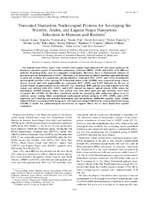Please use this identifier to cite or link to this item:
http://sgc.anlis.gob.ar/handle/123456789/525| DC Field | Value | Language |
|---|---|---|
| dc.contributor.author | Koma, Takaaki | es |
| dc.contributor.author | Yoshimatsu, Kumiko | es |
| dc.contributor.author | Pini, Noemí | es |
| dc.contributor.author | Safronetz, David | es |
| dc.contributor.author | Taruishi, Midori | es |
| dc.contributor.author | Levis, Silvana | es |
| dc.contributor.author | Endo, Rika | es |
| dc.contributor.author | Shimizu, Kenta | es |
| dc.contributor.author | Yasuda, Shumpei P. | es |
| dc.contributor.author | Ebihara, Hideki | es |
| dc.contributor.author | Feldmann, Heinz | es |
| dc.contributor.author | Enria, Delia | es |
| dc.contributor.author | Arikawa, Jiro | es |
| dc.date.accessioned | 2013-06-22T03:50:42Z | - |
| dc.date.available | 2013-06-22T03:50:42Z | - |
| dc.date.issued | 2010-05 | - |
| dc.identifier.issn | 1098-660X | - |
| dc.identifier.uri | http://sgc.anlis.gob.ar/handle/123456789/525 | - |
| dc.description | Fil: Koma, Takaaki. Department of Microbiology, Graduate School of Medicine, Hokkaido University; Japón. | es |
| dc.description | Fil: Yoshimatsu, Kumiko. Takaaki. Department of Microbiology, Graduate School of Medicine, Hokkaido University; Japón. | es |
| dc.description | Fil: Pini, Noemí. ANLIS Dr.C.G.Malbrán. Instituto Nacional de Enfermedades Virales Humanas; Argentina. | es |
| dc.description | Fil: Safronetz, David. Laboratory of Virology, Division of Intramural Research, National Institute of Allergy and Infectious Diseases, National Institutes of Health; Estados Unidos. | es |
| dc.description | Fil: Taruishi, Midori. Takaaki. Department of Microbiology, Graduate School of Medicine, Hokkaido University; Japón. | es |
| dc.description | Fil: Levis, Silvana. ANLIS Dr.C.G.Malbrán. Instituto Nacional de Enfermedades Virales Humanas; Argentina. | es |
| dc.description | Fil: Endo, Rika. Takaaki. Department of Microbiology, Graduate School of Medicine, Hokkaido University; Japón. | es |
| dc.description | Fil: Shimizu, Kenta. Takaaki. Department of Microbiology, Graduate School of Medicine, Hokkaido University; Japón. | es |
| dc.description | Fil: Yasuda, Shumpei P. Takaaki. Department of Microbiology, Graduate School of Medicine, Hokkaido University; Japón. | es |
| dc.description | Fil: Ebihara, Hideki. Laboratory of Virology, Division of Intramural Research, National Institute of Allergy and Infectious Diseases, National Institutes of Health; Estados Unidos. | es |
| dc.description | Fil: Feldmann, Heinz. Laboratory of Virology, Division of Intramural Research, National Institute of Allergy and Infectious Diseases, National Institutes of Health; Estados Unidos. | es |
| dc.description | Fil: Enria, Delia. ANLIS Dr.C.G.Malbrán. Instituto Nacional de Enfermedades Virales Humanas; Argentina. | es |
| dc.description | Fil: Arikawa, Jiro. Takaaki. Department of Microbiology, Graduate School of Medicine, Hokkaido University; Japón. | es |
| dc.description.abstract | Sin Nombre virus (SNV), Andes virus (ANDV), and Laguna Negra virus (LANV) have been known as the dominant causative agents of hantavirus pulmonary syndrome (HPS). ANDV and LANV, with different patterns of pathogenicity, exist in a sympatric relationship. Moreover, there is documented evidence of person-to-person transmission of ANDV. Therefore, it is important in clinical medicine and epidemiology to know the serotype of a hantavirus causing infection. Truncated SNV, ANDV, and LANV recombinant nucleocapsid proteins (trNs) missing 99 N-terminal amino acids (trN100) were expressed using a baculovirus system, and their applicability for serotyping SNV, ANDV, and LANV infection by the use of enzyme-linked immunosorbent assays (ELISA) was examined. HPS patient sera and natural-reservoir rodent sera infected with SNV, ANDV, and LANV showed the highest optical density (OD) values for homologous trN100 antigens. Since even patient sera with lower IgM and IgG antibody titers were serotyped, the trN100s are therefore considered useful for serotyping with early-acute-phase sera. In contrast, assays testing whole recombinant nucleocapsid protein antigens of SNV, ANDV, and LANV expressed in Escherichia coli detected homologous and heterologous antibodies equally. These results indicated that a screening ELISA using an E. coli-expressed antigen followed by a serotyping ELISA using trN100s is useful for epidemiological surveillance in regions where two or more hantavirus species cocirculate. | es |
| dc.format | - | |
| dc.language.iso | en | es |
| dc.publisher | American Society for Microbiology | es |
| dc.relation.ispartof | Journal of clinical microbiology | es |
| dc.rights | openAccess | en_US |
| dc.rights | Creative Commons Attribution 4.0 International License | - |
| dc.rights.uri | http://creativecommons.org/licenses/by/4.0/ | - |
| dc.source | Journal of clinical microbiology 2010; 48(5):1635-1642. | en_US |
| dc.subject | Hantavirus | es |
| dc.subject | Nucleocápside | es |
| dc.subject | Serotipificación | es |
| dc.title | Truncated hantavirus nucleocapsid proteins for serotyping Sin Nombre, Andes, and Laguna Negra hantavirus infections in humans and rodents | es |
| dc.type | Artículo | es |
| dc.identifier.doi | 10.1128/JCM.00072-10 | - |
| anlis.essnrd | 1 | - |
| item.openairetype | Artículo | - |
| item.openairecristype | http://purl.org/coar/resource_type/c_18cf | - |
| item.fulltext | With Fulltext | - |
| item.grantfulltext | open | - |
| item.languageiso639-1 | en | - |
| item.cerifentitytype | Publications | - |
| Appears in Collections: | Preproducción Publicaciones INEVH | |
Files in This Item:
| File | Description | Size | Format | |
|---|---|---|---|---|
| Journalofclinicalmicrobiology,2010,48(5),1635-1642..pdf | Artículo en inglés | 1.27 MB | Adobe PDF |  View/Open |
Page view(s)
164
checked on Jan 2, 2026
Download(s)
36
checked on Jan 2, 2026
Google ScholarTM
Check
Altmetric
Altmetric
This item is licensed under a Creative Commons License


